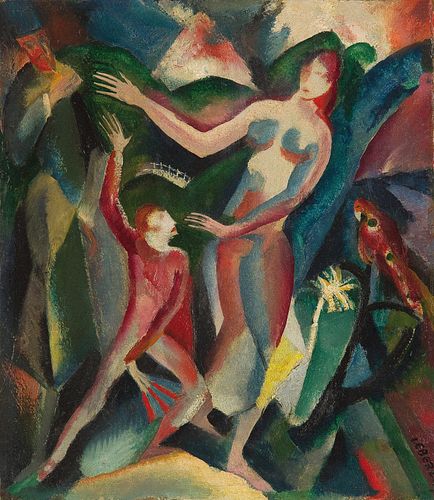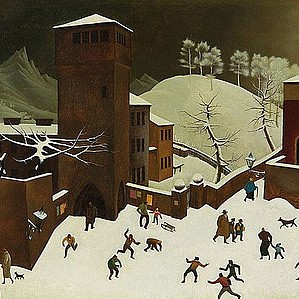JOSEF EBERZ (Limburg an der Lahn 1880 - 1941 Munich) Exotic Dance, 1917
Lot 129
Estimate:
EUR€15,000 - EUR€25,000
$16,304.35 - $27,173.91
Absentee vs Live bid
Two ways to bid:
- Leave a max absentee bid and the platform will bid on your behalf up to your maximum bid during the live auction.
- Bid live during the auction and your bids will be submitted real-time to the auctioneer.
Bid Increments
| Price | Bid Increment |
|---|---|
| EUR€0 | EUR€10 |
| EUR€100 | EUR€50 |
| EUR€700 | EUR€100 |
| EUR€1,000 | EUR€200 |
| EUR€3,000 | EUR€300 |
| EUR€3,600 | EUR€400 |
| EUR€4,000 | EUR€500 |
| EUR€7,000 | EUR€1,000 |
| EUR€16,000 | EUR€2,000 |
| EUR€30,000 | EUR€3,000 |
| EUR€36,000 | EUR€4,000 |
| EUR€40,000 | EUR€5,000 |
About Auction
By Widder Auctions
May 19, 2022
Set Reminder
2022-05-19 11:00:00
2022-05-19 11:00:00
America/New_York
Bidsquare
Bidsquare : Masterpieces
https://www.bidsquare.com/auctions/widder-auctions/masterpieces-9287
Masterpieces of classical modernism by Austrian and international artists coming up for auction in Vienna on May 19th Widder Auctions office@widderauktionen.com
Masterpieces of classical modernism by Austrian and international artists coming up for auction in Vienna on May 19th Widder Auctions office@widderauktionen.com
- Lot Description
JOSEF EBERZ
(Limburg an der Lahn 1880 - 1941 Munich)
Exotic Dance, 1917
oil/cardboard, 34,9 x 30,3 cm
signed J Eberz and dated 17
depicted in Expressiver Realismus in Deutschland, Vienna 2017, p. 13, N. 18
Provenance: private collection Germany, Griesebach Berlin 2014, Fine Arts Widder
ESTIMATE °€ 15.000 - 25.000
German painter, graphic artist and illustrator of the 20th century. Studied at the Academy in Munich from 1901 to 1903 under Franz von Stuck and Hugo von Habermann. Then in Karlsruhe and from 1907 to 1912 master student of the color theorist Adolf Hölzel in Stuttgart. Member of the Hölzel circle, along with Gertrud Alber, Willi Baumeister, Paul Bollmann, Hans Brühlmann, Heinrich Eberhard, Maria Hiller-Foell, Ida Kerkovius, Otto Meyer-Amden, Alfred Heinrich Pellegrini, Oskar Schlemmer, August Ludwig Schmidt, Hermann Stenner and Alfred Wickenburg. Married the artist Gertrud Alber in Wiesbaden in 1917. From 1918 in Munich, represented by the art dealer Hanns Goltz. Member of the New Munich Secession, 1919 of the association Das junge Rheinland, 1919 also of the Darmstadt Secession and the Novembergruppe. In the 1920s travels to Italy, Dalmatia and Paris. His works were classified as degenerate art by the Nazis. Stylistically to be assigned to Expressionism, especially influences of Cubism, Futurism and later Pittura Metafisica. Stylistic proximity to the German Expressionists Conrad Felixmüller, Alexander Kanoldt or Emil Nolde. Created expressionist and color-intensive landscapes and figure paintings, strong interest in religious themes.
Born in Limburg an der Lahn in 1880 as the son of a postal clerk, the painter and graphic artist Josef Eberz studied around the turn of the century in Munich, first under Professors Peter Halm and Franz von Stuck, and then in Düsseldorf and Karlsruhe (both in 1904). He was first challenged at the Stuttgart Academy, where Eberz was enrolled from 1905 as a student of Christian Landenberger, a positive plein-air painter. For Eberz, this professor was probably the real reason for choosing Stuttgart as a training center. But it was only in Adolf Hölzel, the painter of clay nature and genre paintings, that Eberz finally found the artistic figure that formed him. Hölzel, like Eberz, had come to the Stuttgart Art Academy in 1905 and quickly made a name for himself as a painter who was active in art theory and had his own color theory and color circle. As early as 1907 we find Eberz as a master student in Adolf Hölzel's class, in which he studied until 1912. From his teacher, to whom Eberz felt a strong obligation in terms of composition and color in his early pictures, this master student should above all acquire the ability to construct the picture more constructively and to handle color confidently, detached from the real object. The painting "The Exotic Dance" from 1917 reflects this intensive examination of his teacher Hölzel. The two dancers with their colorful shadows and their expressively elongated limbs, the male figure with a hat and red beard fitted into the upper left corner of the picture, the dynamization of the forms and the embedding in a cubist-abstract natural landscape are still in the tradition of the Hölzel circle. In this phase of his work he also met the art collector Heinrich Kirchhoff for the first time, who, along with the art dealer Hans Goltz, was to become one of Josef Eberz's great patrons and in whose garden with its exotic character he also painted from 1917. Walter Müller-Wulckow , who wrote about Eberz in his 1917 contribution to the Kirchhoff Collection, also mentions a painting that shows two dancers, as in the present example: “J. Eberz, on the other hand, masters the uniform stylization with no less great use of color (...). A lyrical element, however, which in Eberz's paintings of large format comes to the fore too much, temporarily prevents this artist from creating life-size figures satisfactorily, such as e.g. B. the two "dancers". From the illustrations of small pictures, on the other hand, one thinks one can infer monumental format, which thus still reveals the power of expansion and at least inner size.”
PLEASE NOTE:
The purchase price consists of the highest bid plus the buyer's premium, sales tax and, if applicable, the fee of artists resale rights. In the case of normal taxation (marked ° in the catalog), a premium of 24% is added to the highest bid. The mandatory sales tax of 13% is added to the sum of the highest bid and the buyer's premium. The buyer's premium amounts to 28% in case of differential taxation. The sales tax is included in the differential taxation. - Shipping Info
-
Shipping
We will send you the invoice shortly after the auction. As soon as we have recieved the amount, the art can be picked up at Johannesgasse 9-13, 1010 Vienna. Please note that the buyer is responsible for pick-up and shipping of the lot.
Should you wish to ship your items, please contact: Mailboxes Email: oper@mbe-co.at Tel: 01 5128855
Please note that storage fees may apply, should the pieces not be picked up within 14 days after invoicing for domestic and 28 days for international transportation.
Our team will be happy to assist you with any further information at office@widderauktionen.com or at 0043 676 555 66 10.
-
- Buyer's Premium



 EUR
EUR CAD
CAD AUD
AUD GBP
GBP MXN
MXN HKD
HKD CNY
CNY MYR
MYR SEK
SEK SGD
SGD CHF
CHF THB
THB













